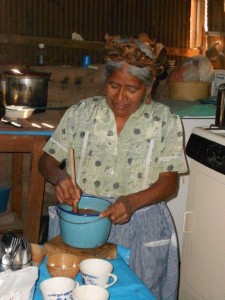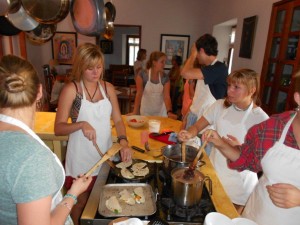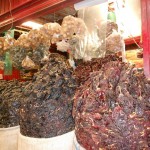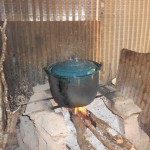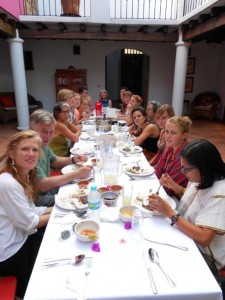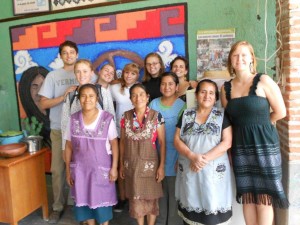I am no stranger to the food culture in Oaxaca, Mexico. Over the past few years, during my month-long stays in this region, I’ve become familiar with local ingredients, agriculture, and the challenges this deeply-rooted culture experiences with modern-day agricultural policies, processes, and plight.
I come here to teach students at the University of Vermont about food systems – it is a way for them to see first-hand how economic, environmental, health and social forces all affect, and are affected by, the food system. Through a combination of lectures, readings, fieldwork, excursions, cooking and eating in our local kitchen classroom, they learn about the entire supply chain, from seed-to-plate.
In preparation for the course, I did field work with a colleague. We had the privilege of working with Chef Pilar Cabera of La Olla restaurant on tamale-making.
Tamales, a local food staple
Tamales are a pre-Hispanic dish of ground corn covered in a rich sauce, and then steamed in banana leaf or corn husk. After the Spanish arrived, chicken, pork and other meats were added as well as lard. There are also dessert tamales of corn mixed with something sweet, like berries and brown sugar.
The large metal steamers in which tamales are cooked are reminiscent of lobster pots and can accommodate 25-50 snuggly. During fiestas (which are numerous) the tamale pots are gigantic and can accommodate hundreds of these steamed delicacies.
The beautiful thing about tamales is that they are easy to handle, require no silverware or plate, and what’s left over is completely compostable.
But all is not well in tamale land. For nearly 20 years, the Oaxacan food culture has been thrown into the balance by forces outside of its control – namely, international politics. It’s an example that shows the complex inner-workings of local and global food systems.
For centuries, the cornerstone of the Mexican diet, culture, and economy was corn – and it still is today. This is, in fact, corn’s birthplace and home to thousands of varieties of corn thanks to Mexico’s varied climate and history of seed cultivation and harvesting.
The complex role of corn in day-to-day life is immediately apparent in the rugged and isolated terrain of Oaxaca, where corn is at the foundation of the local community. Village women perform the daily task of making corn tortillas known as “blandas,” a staple of Oaxacan meals, just as their ancestors did centuries ago. The remoteness of this region has kept many culinary traditions intact.
It’s symbolic of a larger national commitment to sustainably farming, sourcing and producing corn and corn products. For thousands of years, farmers all over Mexico gathered together at the end of each growing season to select the best corn seeds for their agricultural terrain. The process gave birth to thousands of varieties of corn throughout the country, each uniquely suited to the climate and geography of the place in which it is grown. Talk about taste of place!
But that’s not all. Through this natural process, Mexican varieties often have the best yield, pest resistance, growth cycle, drought resistance and protein content.
NAFTA
In the early 1990s, however, the quality of Mexican corn took a turn for the worse: the North American Free Trade Agreement (NAFTA) was passed, which included free trade of Mexico’s staple crop. Much of the heritage corn is under threat because its being replaced by what the Mexicans call cheap “pig corn” from the US. Like Americans, Mexicans are conscious of their food budgets, and are replacing these ancient varieties with cheaper, less nutritious and tasty American varieties.
But, in my opinion, cheaper isn’t always better.
Introducing genetically-modified, hybrid American corn into Mexico contaminates local varieties. Farmers suffer lower yield on crops as U.S. seed makes its way into their fields. Because of the varied climate and lack of pesticides and heavy machinery, the one-size-fits-all method doesn’t work in Mexico.
And the results are tragic:
- Between 1994-2000, with the insurgence of U.S. corn, Mexican corn prices were cut in half to reflect international prices.
- Lack of rural farm subsidies caused many farmers to seek employment in urban areas, where jobs were also lacking.
- The migration of farmers from the land to city deteriorated the vital, centuries-old practice of seed selection, directly impacting the quality of Mexican corn varieties.
A once vibrant food system is now struggling to survive.
Don’t despair though, there are several organizations here in Mexico who are coming together to prevent this from continuing, including Nuestro Maiz, an NGO dedicated to preserving Oaxaca’s corn heritage, and Itatoni Tortilleria, a restaurant and non-profit with an agronomist for its owner, dedicated to the preservation of traditional corn varieties used in making traditional Oaxacan tacos, tostadas, quesadillas, memelas, tetelas, tlayudas, tamales and pozole. School-aged children and teenagers participate in lectures and interactive workshops that focus on heritage corn and the need to protect it. Even the government, notorious for its corruption, is stepping in to create protection laws, especially in Oaxaca.
You can see more from our trip to Oaxaca at our students’ blog.
Have you observed any food cultures under threat around our world? Please share your thoughts by leaving a comment below.






